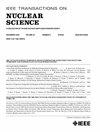利用激光康普顿散射伽马射线的核共振荧光对 239Pu 进行针孔成像的模拟研究
IF 1.9
3区 工程技术
Q3 ENGINEERING, ELECTRICAL & ELECTRONIC
引用次数: 0
摘要
核共振荧光(NRF)因其对不同原子核的特异性,在同位素的鉴定和测量方面具有巨大潜力。本研究通过蒙特卡洛模拟探索了检测 239Pu 样品的核共振荧光针孔成像方法。通过设计和优化针孔成像系统的参数,包括入射光子方向、几何孔径、接受角、针孔厚度、物距和放大系数,实现了 1.2 厘米的空间分辨率和 1.63 的信噪比(SNR)。模拟中使用了单色入射光子,以改善数据统计并减少计算时间。虽然没有合适的单色光子束,但激光康普顿散射(LCS)源产生的准单色伽马射线可用于 NRF 应用。利用准单色入射光子光束进行的模拟表明,经过能量过滤后,非共振光子对最终结果的影响很小。模拟结果表明,NRF 针孔成像技术可以区分不同浓度和尺寸的同位素样品(如 239Pu),并获得直接成像结果,而无需进一步的数据处理。然而,高能量噪声光子和低计数率 NRF 光子等挑战限制了成像质量。为了弥补这些误差并提高 NRF 针孔成像的准确性,可以开发成像校正算法来进一步改进。本文章由计算机程序翻译,如有差异,请以英文原文为准。
Simulation Study on Pinhole Imaging of ²³⁹Pu Using Nuclear Resonance Fluorescence With Laser Compton Scattering Gamma Rays
Nuclear resonance fluorescence (NRF) has significant potential in the identification and measurement of isotopes due to its specificity for different nuclei. This study explored the NRF pinhole imaging method through Monte Carlo simulation in the detection of 239Pu samples. By designing and optimizing parameters of the pinhole imaging system, including the direction of incident photons, geometric aperture, acceptance angle, pinhole thickness, object distance, and magnification factor, a spatial resolution of 1.2 cm with a signal-to-noise ratio (SNR) of 1.63 has been achieved. Monochromatic incident photons were used in the simulation to improve data statistics and reduce computation time. Although there are no suitable monochromatic photon beams, quasi-monochromatic gamma rays generated by laser Compton scattering (LCS) sources would be available for NRF applications. Simulation with a quasi-monochromatic incident photon beam suggested that off-resonance photons contributed little to the final results after energy filtering. Simulation results demonstrate the potential of NRF pinhole imaging to distinguish isotope samples, such as 239Pu, with different concentrations and sizes and obtain direct imaging results without the need for further data processing. However, challenges, such as high-energy noise photons and low count rate of NRF photons, limit the image quality. To compensate these errors and enhance the accuracy of NRF pinhole imaging, imaging correction algorithms can be developed for further improvements.
求助全文
通过发布文献求助,成功后即可免费获取论文全文。
去求助
来源期刊

IEEE Transactions on Nuclear Science
工程技术-工程:电子与电气
CiteScore
3.70
自引率
27.80%
发文量
314
审稿时长
6.2 months
期刊介绍:
The IEEE Transactions on Nuclear Science is a publication of the IEEE Nuclear and Plasma Sciences Society. It is viewed as the primary source of technical information in many of the areas it covers. As judged by JCR impact factor, TNS consistently ranks in the top five journals in the category of Nuclear Science & Technology. It has one of the higher immediacy indices, indicating that the information it publishes is viewed as timely, and has a relatively long citation half-life, indicating that the published information also is viewed as valuable for a number of years.
The IEEE Transactions on Nuclear Science is published bimonthly. Its scope includes all aspects of the theory and application of nuclear science and engineering. It focuses on instrumentation for the detection and measurement of ionizing radiation; particle accelerators and their controls; nuclear medicine and its application; effects of radiation on materials, components, and systems; reactor instrumentation and controls; and measurement of radiation in space.
 求助内容:
求助内容: 应助结果提醒方式:
应助结果提醒方式:


